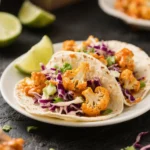Vegan Teriyaki Salmon-free Cauliflower “Salmon” (Plant-Based)
Indulge in a delicious, sustainable, and cruelty-free twist on a classic Japanese favorite with this Vegan Teriyaki Salmon-free Cauliflower “Salmon.” This plant-based dish transforms humble cauliflower into a flaky, savory, golden-brown “salmon” fillet using a magical marinade and a few simple techniques that mimic the texture and flavor of real salmon. Perfect for vegans, vegetarians, or anyone looking to reduce their seafood consumption without sacrificing taste, this recipe brings together umami-rich teriyaki glaze, seaweed-infused depth, and oven-roasted perfection to create a truly satisfying main course.
The History
The concept of plant-based “seafood” is not as modern as one might think. For centuries, Buddhist monks in East Asia have developed meat- and fish-free alternatives using tofu, mushrooms, konjac, and vegetables to emulate animal proteins during religious fasting periods. In Japan, this tradition gave rise to shojin ryori—a style of vegetarian cooking deeply rooted in Zen Buddhism. The use of seaweed, soy sauce, and fermented ingredients provided a natural umami profile similar to fish.
Fast forward to the 21st century, where concerns about overfishing, ocean pollution, and animal welfare have led to a surge in innovative plant-based seafood alternatives. Companies like Good Catch and Sophie’s Kitchen pioneered commercial vegan tuna and crab, but home cooks have also embraced the challenge of replicating seafood textures and flavors using whole foods. Cauliflower, with its neutral taste and flaky texture when roasted, has emerged as a favorite base for vegan “fish” dishes.
This particular recipe draws inspiration from both traditional Japanese flavors and modern vegan culinary science. By marinating cauliflower in a nori- and soy-based mixture, then roasting it to achieve a firm yet tender bite, we simulate the experience of eating grilled salmon—complete with glossy teriyaki glaze and a hint of oceanic aroma—all without a single fish involved.
Ingredients Breakdown
The success of this dish lies in the careful selection and combination of ingredients that build layers of flavor, color, and texture. Let’s dive into each component:
- Cauliflower: The star of the show. When sliced into steaks and roasted, cauliflower develops a tender, almost meaty texture that flakes apart like cooked fish. Choose a large, dense head with tightly packed florets for best results.
- Soy Sauce or Tamari: Provides saltiness and deep umami. Use tamari for a gluten-free option.
- Maple Syrup: Balances the saltiness with natural sweetness, essential for authentic teriyaki flavor.
- Rice Vinegar: Adds brightness and helps tenderize the cauliflower while enhancing the marinade’s tang.
- Garlic and Ginger: Freshly minced for aromatic depth and a subtle kick.
- Nori Sheets: Toasted seaweed sheets are blended into the marinade to impart that unmistakable oceanic flavor reminiscent of sushi-grade fish.
- Sesame Oil: A small amount adds richness and nuttiness, elevating the overall savoriness.
- Smoked Paprika: Gives the cauliflower a warm, slightly smoky tone—echoing the charred edges of grilled salmon.
- Liquid Smoke (optional): A tiny drop enhances the grilled effect without overpowering.
- Nutritional Yeast: Adds a cheesy, umami boost and helps deepen the savory notes.
- Arrowroot or Cornstarch: Used to thicken the teriyaki glaze into a luscious, restaurant-style coating.
- Green Onions and Sesame Seeds: For garnish, adding freshness, crunch, and visual appeal.
Step-by-Step Recipe
- Prepare the Cauliflower Steaks: Remove the leaves and stem from a large head of cauliflower. Place it upright on a cutting board and slice crosswise into ¾-inch thick “steaks” (you should get 2–3 slices). Reserve remaining florets for roasting or another use.
- Make the Marinade: In a blender or food processor, combine 2 tablespoons soy sauce, 1 tablespoon maple syrup, 1 tablespoon rice vinegar, 1 clove minced garlic, 1 teaspoon grated ginger, 1 crumbled sheet of nori, ½ teaspoon sesame oil, ¼ teaspoon smoked paprika, a pinch of liquid smoke (if using), and 1 tablespoon nutritional yeast. Blend until smooth.
- Marinate the Steaks: Place the cauliflower steaks in a shallow dish and brush the marinade generously on both sides. Let sit for at least 30 minutes (or up to 2 hours in the fridge) to absorb flavors.
- Preheat Oven: Preheat your oven to 400°F (200°C). Line a baking sheet with parchment paper or a silicone mat.
- Roast the Cauliflower: Arrange marinated steaks on the baking sheet. Roast for 20 minutes, then carefully flip and roast for another 15–20 minutes until golden brown, slightly crispy on the edges, and tender when pierced with a fork.
- Prepare the Teriyaki Glaze: While the cauliflower roasts, make the glaze. In a small saucepan, combine ¼ cup soy sauce, 3 tablespoons maple syrup, 2 tablespoons water, 1 teaspoon rice vinegar, 1 clove minced garlic, and ½ teaspoon grated ginger. Bring to a simmer over medium heat.
- Thicken the Glaze: In a small bowl, mix 1 teaspoon arrowroot powder with 1 tablespoon cold water to make a slurry. Stir into the simmering sauce and cook for 1–2 minutes until thickened and glossy. Remove from heat.
- Glaze the Steaks: Once the cauliflower is roasted, transfer the steaks to a clean baking sheet or plate. Brush both sides generously with the warm teriyaki glaze. Return to the oven for 5 minutes to caramelize the glaze slightly.
- Serve: Plate the cauliflower “salmon” steaks over a bed of sushi rice, jasmine rice, or quinoa. Drizzle with extra teriyaki sauce, sprinkle with sliced green onions, toasted sesame seeds, and optional extra nori strips for authenticity.
Tips
- Uniform Slicing: Cut even steaks to ensure consistent cooking. If the center core is too tough, you can remove it gently after slicing.
- Don’t Skip the Nori: It’s what gives the “fishy” essence. You can grind dried nori into a fine powder if blending is difficult.
- Marination Time: Longer marination (up to 2 hours) yields deeper flavor penetration. Avoid exceeding 2 hours as acidity can start to break down the cauliflower too much.
- Flipping Carefully: Use a thin spatula to flip the steaks halfway through roasting—they’re delicate but hold together well if not disturbed too early.
- Broil for Crispness: For extra browning, broil for 1–2 minutes at the end (watch closely to prevent burning).
- Glaze Twice: Brushing glaze before and after the final roast creates a sticky, restaurant-quality finish.
- Use Leftover Marinade? Do not reuse raw marinade on cooked food unless boiled first. Set aside a portion before marinating if you want extra sauce.
Variations and Customizations
This versatile recipe welcomes creativity. Here are some ways to switch it up:
- Crusted Version: After roasting, coat the steaks in panko breadcrumbs mixed with sesame seeds and nori, then air-fry or bake briefly for a crispy “battered” texture.
- Grilled Option: Use a grill pan or outdoor grill for authentic char marks and smoky flavor. Oil the grates well to prevent sticking.
- Spicy Teriyaki: Add sriracha, chili garlic paste, or red pepper flakes to the glaze for a kick.
- Pineapple Twist: Replace half the maple syrup with pineapple juice in the teriyaki sauce for a tropical flair.
- Sushi Bowl Style: Serve over seasoned sushi rice with cucumber ribbons, pickled ginger, avocado, and wasabi mayo for a full vegan sushi experience.
- Baked Tacos: Flake the roasted cauliflower and use as a filling for soft tacos with cabbage slaw and mango salsa.
- Dashi Boost: Add a splash of vegan dashi (made from kombu and shiitake) to the marinade for deeper oceanic complexity.
- Protein-Packed: Pair with edamame, baked tofu, or tempeh for added protein.
Health Considerations and Nutritional Value
This plant-based dish offers numerous health benefits compared to traditional salmon, especially for those avoiding mercury, microplastics, or cholesterol found in seafood.
Nutritional Highlights (per serving, based on 2 servings):
- Calories: ~220–250 kcal
- Protein: 8–10g (from cauliflower, soy, and nutritional yeast)
- Fat: 5–7g (mostly heart-healthy unsaturated fats from sesame oil)
- Carbohydrates: 40–45g (naturally occurring sugars and fiber)
- Fiber: 6–8g (supports digestion and gut health)
- Sodium: Varies based on soy sauce; can be reduced using low-sodium versions
- Vitamins & Minerals: Rich in vitamin C, K, folate, potassium, and antioxidants from cauliflower and ginger
- Iodine: Provided naturally by nori, supporting thyroid function
Health Advantages:
- Cholesterol-free and low in saturated fat
- Rich in anti-inflammatory compounds (ginger, garlic, cruciferous veggies)
- No environmental contaminants (mercury, PCBs)
- Suitable for heart-healthy, diabetes-friendly, and weight-conscious diets when portion-controlled
Considerations:
- Monitor sodium intake by using reduced-sodium soy sauce or tamari.
- Maple syrup adds natural sugar; reduce or substitute with monk fruit or date syrup for lower glycemic impact.
- Nori is high in iodine—beneficial in moderation, but excessive intake may affect thyroid health in sensitive individuals.
Ingredients
- 1 large head of cauliflower, cut into ¾-inch steaks (2–3 pieces)
- 3 tablespoons soy sauce (or tamari for gluten-free)
- 2 tablespoons pure maple syrup
- 1 tablespoon rice vinegar
- 1 clove garlic, minced
- 1 teaspoon fresh ginger, grated
- 1 sheet nori, crumbled
- ½ teaspoon sesame oil
- ¼ teaspoon smoked paprika
- ⅛ teaspoon liquid smoke (optional)
- 1 tablespoon nutritional yeast
- 2 tablespoons water (for marinade consistency)
- 1 teaspoon arrowroot powder or cornstarch
- Toasted sesame seeds and sliced green onions, for garnish
Directions
- Preheat oven to 400°F (200°C). Line a baking sheet with parchment paper.
- In a blender, combine 2 tbsp soy sauce, 1 tbsp maple syrup, 1 tbsp rice vinegar, garlic, ginger, nori, sesame oil, smoked paprika, liquid smoke (if using), nutritional yeast, and 2 tbsp water. Blend until smooth.
- Place cauliflower steaks in a dish and brush marinade on both sides. Marinate for 30 minutes to 2 hours in the refrigerator.
- Arrange steaks on the prepared baking sheet. Roast for 20 minutes, flip carefully, then roast another 15–20 minutes until tender and golden.
- While roasting, prepare teriyaki glaze: In a saucepan, combine ¼ cup soy sauce, 3 tbsp maple syrup, 2 tbsp water, 1 tsp rice vinegar, garlic, and ginger. Simmer over medium heat.
- Mix arrowroot with 1 tbsp cold water. Stir into the sauce and cook 1–2 minutes until thickened. Remove from heat.
- Remove cauliflower from oven. Brush both sides with teriyaki glaze and return to oven for 5 minutes to set the glaze.
- Serve hot over rice, drizzled with extra glaze, and garnished with green onions and sesame seeds. Optional: add nori strips for sushi-style presentation.
FAQ
Q: Can I make this ahead of time?
A: Yes! Marinate the cauliflower up to 24 hours in advance. Cook just before serving for best texture. Leftovers keep well refrigerated for 3–4 days and reheat beautifully in the oven or air fryer.
Q: Why does my cauliflower fall apart?
A: Over-marinating, slicing too thin, or flipping too early can cause breakage. Stick to ¾-inch steaks and avoid disturbing them until halfway through roasting.
Q: Can I freeze this dish?
A: Not recommended. Cauliflower tends to become watery upon thawing. Best enjoyed fresh or refrigerated short-term.
Q: Is there a substitute for nori?
A: Nori is key for the seafood flavor. Dulse flakes or kelp granules can work, but the taste will differ slightly. Avoid skipping it entirely for authentic results.
Q: Can I use frozen cauliflower?
A: No. Frozen cauliflower releases too much moisture and won’t hold its shape. Always use fresh.
Q: How do I make it oil-free?
A: Omit sesame oil and roast on ungreased parchment. The flavor will be lighter but still delicious.
Q: Can I use store-bought teriyaki sauce?
A: Yes, but check labels for animal products (some contain honey or fish derivatives). Opt for vegan-certified brands and consider thickening with arrowroot for a glossier finish.
Summary
Satisfy your sushi cravings guilt-free with this flavorful, flaky Vegan Teriyaki Salmon-free Cauliflower “Salmon” that masterfully mimics the taste and texture of real fish using simple, wholesome ingredients. Packed with umami, nutrition, and sustainability, this dish proves that plant-based eating can be both indulgent and transformative.










